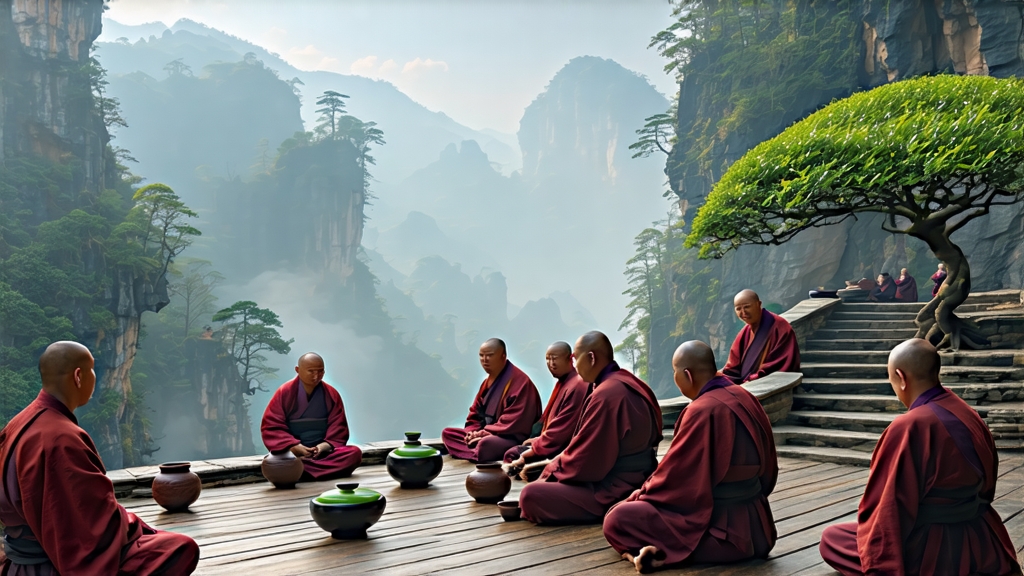
If green tea is China’s springtime whisper and pu-erh its autumnal soliloquy, then Da Hong Pao—Big Red Robe—is the craggy cliff’s baritone echo that has been reverberating across the Wuyi Mountains for more than three centuries. To international drinkers the name may sound theatrical, yet every leaf carries the weight of imperial legend, geological miracle and human devotion. This article invites you to step onto the narrow plank paths bolted to sheer rock faces, smell the charcoal embers that have been kept alive overnight, and finally taste the amber liquor that Chinese connoisseurs call “the blood of the mountain.”
-
From Imperial Robe to Leafy Nobility
The most quoted origin tale dates to the Ming dynasty (1368-1644). A Ming emperor’s mother fell gravely ill; monks from the Wuyi Tianxin Temple presented a tea plucked from six ancient bushes clinging to Jiulongke cliff. The empress recovered, and the emperor sent crimson silk robes to drape the bushes in gratitude—hence “Big Red Robe.” While historians debate the medical miracle, tax records from 1655 list “Yancha” (rock tea) as tribute, proving that these bushes were already valued above gold. Today the original six “mother trees” are preserved, their cuttings protected by UNESCO as a living World Heritage genotype. -
Terroir: When Granite Breathes
The Wuyi range is a 550-million-year-old igneous spine whose cliffs heat up during the day and radiate warmth at night, creating a 10-15 °C diurnal swing. Thin moss-covered soil forces roots to penetrate fissures, absorbing minerals that give Da Hong Pao its signature “rock rhyme” (yanyun)—a tactile, almost lithic minerality that lingers behind the tongue like the after-ring of a bronze bell. Nine tributaries cut through the valleys, each adding a micro-climate; thus tea from “Horse Head Rock” tastes of wet slate, while “Tiger Roar Cliff” yields orchid and honey. -
Varietal Genealogy: Sibblings under One Robe
Strictly speaking, “pure” Da Hong Pao refers only to tea from the six mother trees, yielding less than 500 g per year auctioned at tens of thousands of dollars. The market offers three categories:- Beidou & Queshe: Clonal offspring propagated by soft-wood cuttings, genetically identical, cultivated in the core 60 km² reserve.
- Blended Qipao: Leaves from approved Wuyi cultivars (Rougui, Shui Xian, Tie Luo Han) skillfully married to recreate mother-tree complexity.
- Aromatic styles: Modern light-roast versions highlighting floral top notes for entry-level drinkers. Knowing the code on the tin—ZK (Zhongke) for research-institute clones, ST (Shuitian) for traditional gardens—helps buyers navigate.
-
Craftsmanship: The Eight-Act Drama
Plucking begins at dawn when dew still weighs down the two leaves and a bud, ensuring turgid cells that withstand the bruising ahead. What follows is an eight-step choreography unique to Wuyi:
a. Wilting under mountain breeze on bamboo racks for two hours.
b. Yaoqing—“trembling green”—rhythmic tossing in a willow basket to fracture cell walls, initiating oxidation.
c. Shaqing: a 280 °C wok kill-green for eight seconds that locks in 30 % oxidation, the hallmark of oolong.
d. Rudiao: hand-rolling until leaf edges crumble yet veins stay intact, forming the characteristic “dragonfly head” shape.
e. First roast over charcoal embers at 100 °C for two hours, followed by a month’s rest to let “fire breath” dissipate.
f. Second roast at 80 °C, then aging in earthen jars for at least 90 days; premium lots see three cycles across 18 months.
g. Final sorting by leaf size and color so that each basket steeps uniformly.
h. “Return to mountain”: craftsmen re-taste and micro-adjust with 5 g additions of older vintages, ensuring batch-to-batch continuity. -
Brewing: The Gongfu Dialogue
Western teapots flatten Da Hong Pao’s topography; instead, use